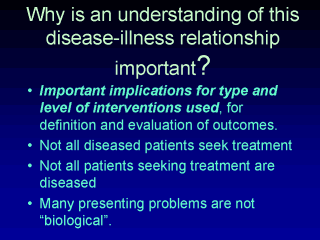| front |1 |2 |3 |4 |5 |6 |7 |8 |9 |10 |11 |12 |13 |14 |15 |16 |17 |18 |19 |20 |21 |22 |23 |24 |25 |26 |27 |28 |29 |30 |31 |32 |33 |34 |35 |36 |37 |38 |review |
 |
Choosing the right
model by which to understand disease has important implications. 1. It influences in what way, for whom, under what circumstances and at what costs attempts are made to intervene to treat or manage disease or promote or maintain health. 2. It influences our choice of outcomes used to determine the effectiveness and efficiency of interventions we might use. A good model should not only explain histopathology, but also explain why not all people with active disease seek treatment, why not all patients seeking treatment are diseased and why many presenting problems are not biological, even though they may imply disease. The mechanistic-reductionist models of disease developed in 18th entury European are still thought by many to be adequate. However, as indicated by the shift in the emphasis that is taking place in your medical education and in health services delivery, this model may be a necessary component of a wider picture, but by itself it is not a sufficient component and any doctor failing to recognise this remains embedded firmly in an increasingly out of date view of the world. He or she places themselves at significant professional risk as a result. |